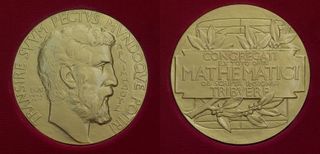A Woman Finally Wins Top Math Prize 'Fields Medal'

For the first time in history, the Fields Medal — the equivalent of the Nobel Prize for mathematics — will be awarded to a woman. The award will go to Maryam Mirzakhani, an Iranian mathematician and professor of mathematics at Stanford University.
Mirzakhani and three other mathematicians will be honored for their original contributions to the field, at the International Congress of Mathematicians (ICM) today (Aug. 13) in Seoul, South Korea. The Fields Medal is the most prestigious international award for mathematics, a field that is missing from Nobel Prize categories. The award is given every four years to accomplished mathematicians under age 40. The first Fields Medal was awarded in 1936, and none of the recipients have been female until now.
"This is a great honor. I will be happy if it encourages young female scientists and mathematicians," Mirzakhani said in a statement. "I am sure there will be many more women winning this kind of award in coming years." [The 11 Most Beautiful Mathematical Equations]
Mirzakhani is being awarded the Fields Medal for her outstanding contributions to the understanding the dynamics and geometry of "Riemann surfaces and their moduli spaces," according to the International Mathematical Union.
Riemann surfaces are geometric objects whose points each represent a different surface. They are mostly theoretical, but some examples include amoebaes and doughnuts, according to a Stanford statement.

"Perhaps Maryam's most important achievement is her work on dynamics," Curtis McMullen of Harvard University, who was Mirzakhani's doctoral adviser, told the New York Times. There are no exact mathematical solutions for many dynamical systems, which involve surfaces with many handles, like pretzels, McMullen added. "What Maryam discovered is that in another regime, the dynamical orbits are tightly constrained to follow algebraic laws." Mirzakhani was born in 1977 in Tehran, and grew up thinking she would become a writer one day. But she later became interested in mathematics in high school and chose it as her field of study at one of Iran's top schools, Sharif University of Technology. Mirzakhani received her doctoral degree in 2004 from Harvard University and became a professor at Stanford University in 2008.
The other recipients of 2014 Fields Medal are Artur Avila of Denis Diderot University in Paris, Martin Hairer of the University of Warwick, and Manjul Bhargava of Princeton University. To see how Mirzakhani and other awardees explain their work, check out their profiles in Quanta Magazine.
Sign up for the Live Science daily newsletter now
Get the world’s most fascinating discoveries delivered straight to your inbox.
Email Bahar Gholipour. Follow Live Science @livescience, Facebook & Google+. Originally published on Live Science.

Most Popular

